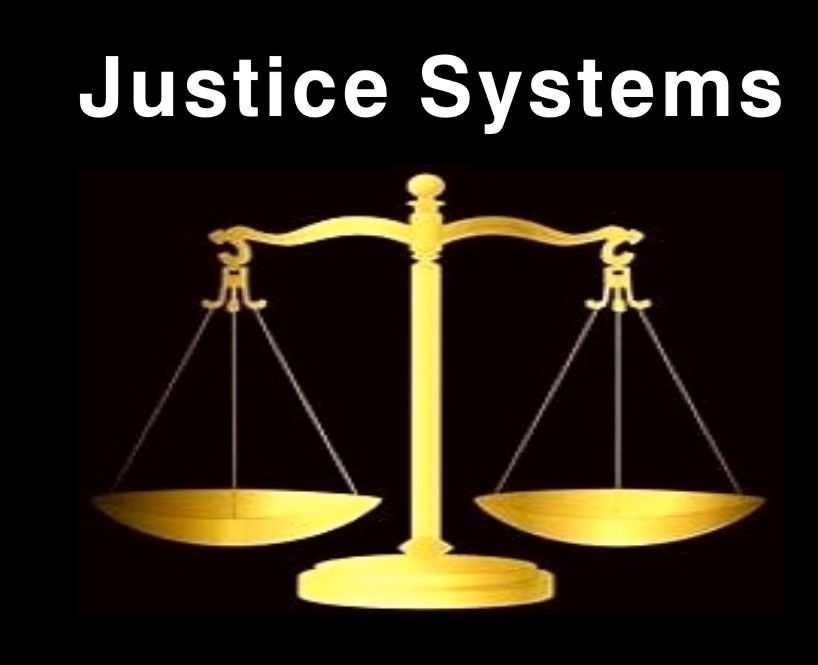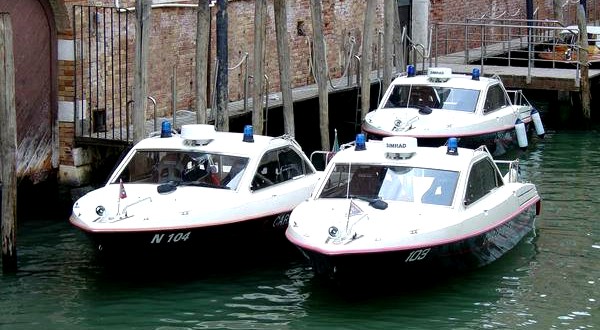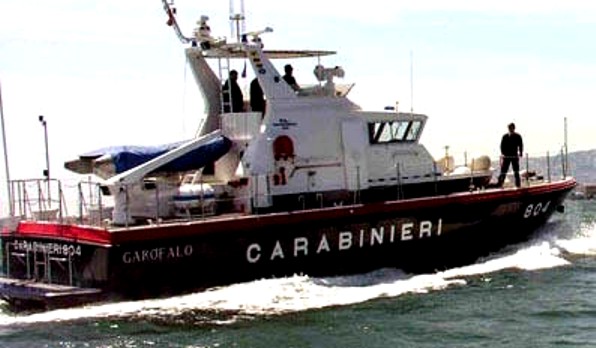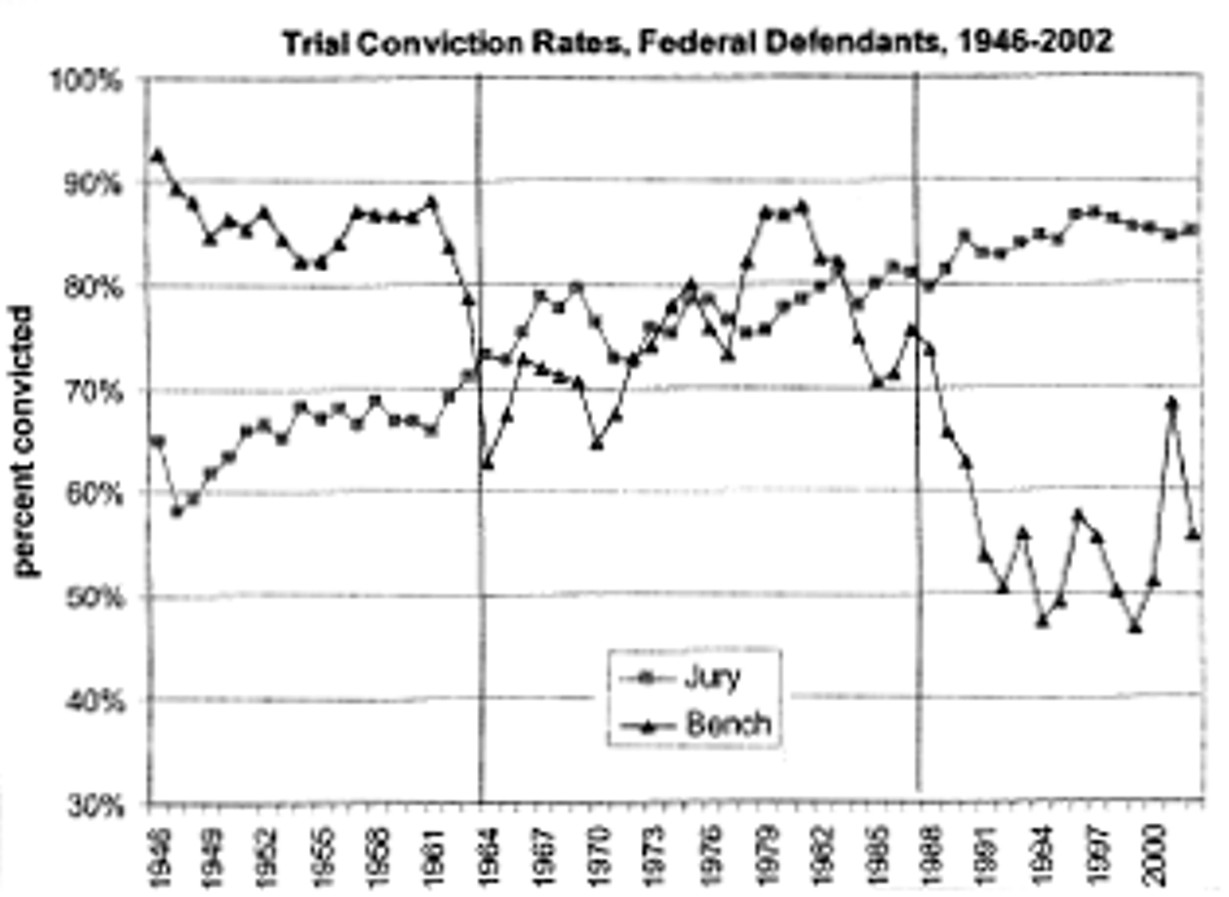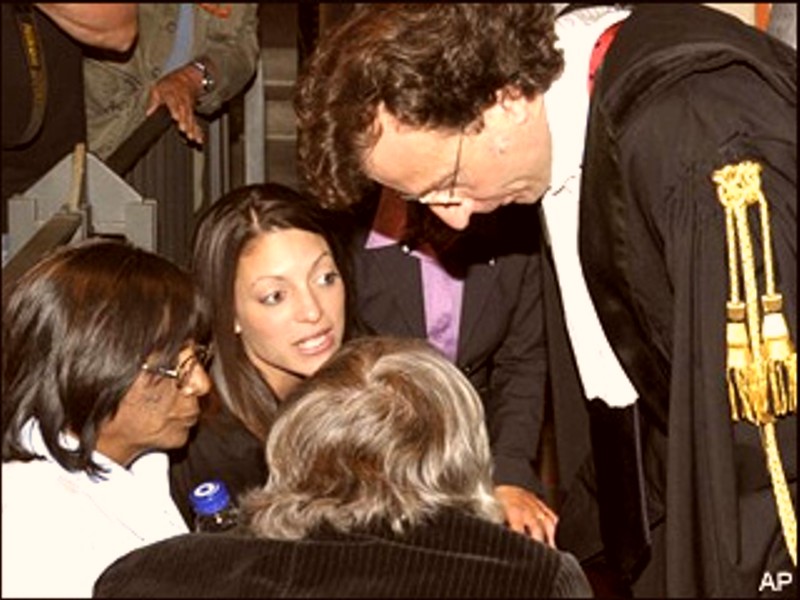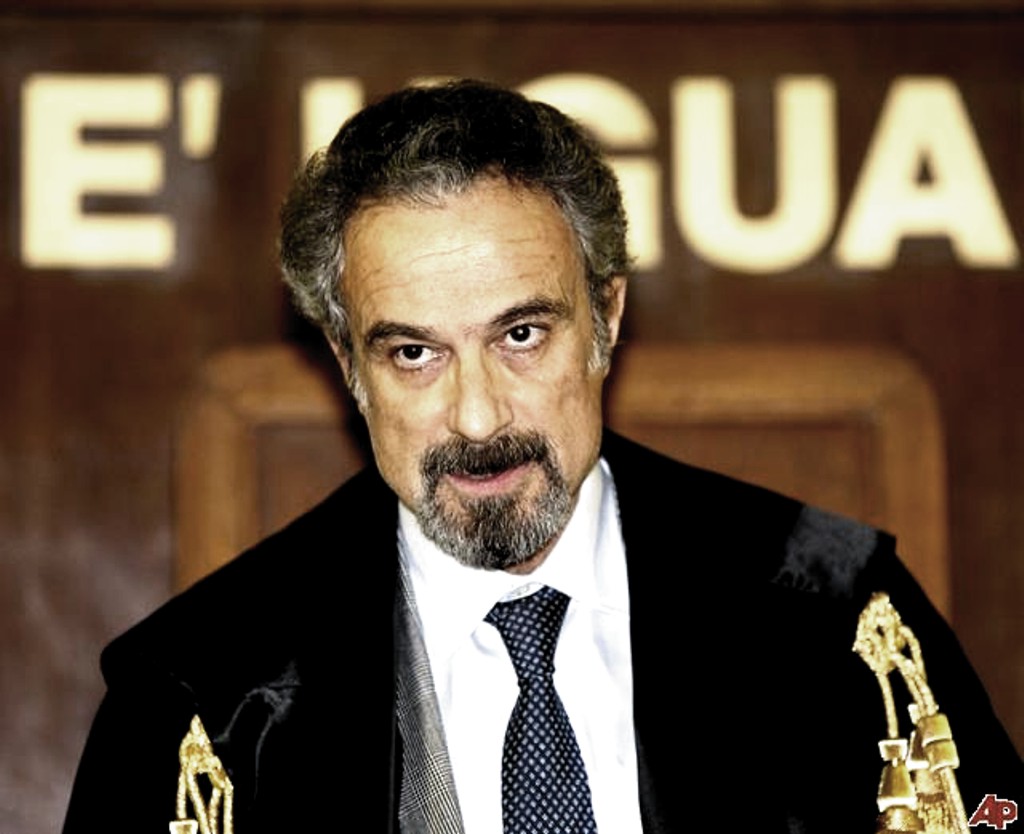
Category: The officially involved
Another Effective Innovation By New York Police Is Being Duplicated By Others
Posted by Peter Quennell

Police horses, up to a dozen stroked and photographed each evening in the Times Square area
In national US news any innovation of the New York police gets a lot of coverage.
Those crowd-calming police horses seen nightly in the Times Square area go way back, and their presence was never reduced back when some other cities did so - often to their later regret.
There is endemic pressure (especially after 9/11) to keep the city as safe as possible.
From that sustained effort at systems improvement, other American police forces, some very besieged at the moment, attempt to learn something.
New York police both themselves innovate and also adopt good ideas from elsewhere - not least from the brave, popular and effective police forces of Italy.
We posted in January 2013 on New York’s adoption of an Italian approach to policing.
One approach which seems a natural for Italy with all of its art is proving successful in New York now.
Described in the NY Times today is this ongoing exercise in staring at artworks. The point being to sharpen the perceptions of investigators, and to put them all on the same page objectively.
To teach people how to notice details they might otherwise miss, Amy E. Herman, an expert in visual perception, likes to take them to museums and get them to look at the art. Recently she escorted a group of New York City police officers to the Metropolitan Museum of Art and asked them to describe some of the things they saw.
They did their best. “This seems to be a painting of some males with horses,” one officer said of Rosa Bonheur’s mid-19th-century work “The Horse Fair,” a scene of semi-chaos as horses are driven to market. He tried to abide by Ms. Herman’s admonishment to avoid words like “obviously.” “It appears to be daytime, and the horses appear to be traveling from left to right.”
Another pair of officers tackled Picasso’s 1905 “At the Lapin Agile,” which depicts a wilted-looking couple sitting at a French bar after what might have been a long night out. “They appear to have had an altercation,” one observed. The other said, “The male and female look like they’re together, but the male looks like he’ll be sleeping on the couch.”
The officers asked that their names not be used because they were not authorized to speak to reporters. They said that they did not know much about art “” their jobs allow little opportunity for recreational museumgoing “” and Ms. Herman said she preferred it that way.
“I’ve had people say, “˜I hate art,’ and I say, “˜That’s not relevant,’” she said. “This is not a class about Pollock versus Picasso. I’m not teaching you about art today; I’m using art as a new set of data, to help you clear the slate and use the skills you use on the job. My goal when you walk out the door is that you’re thinking differently about the job.”
A painting has many functions. It’s a cultural artifact, an aesthetic object, an insight into a time and a place, a piece of commerce. To Ms. Herman, it’s also an invaluable repository of visual detail that can help shed light on, say, how to approach a murder scene. “It’s extremely evocative and perfect for critical inquiry,” she said in an interview. “What am I seeing here? How do I attach a narrative to it?”
One of the processes:
Before unleashing the officers in the galleries, she talked to them in a classroom in the Met’s basement. She put up a slide of “Mrs. John Winthrop,” a 1773 portrait by John Singleton Copley. The painting, showing a woman sitting at a table holding little pieces of fruit, is considered a masterpiece of fine detail “” the intricacy of the lace trim on the lady’s gown, the rich decorations on her hat. But there’s a detail that’s so obvious, or maybe so seemingly irrelevant, that most people fail to mention it in their description.
“Everyone sees that this is a woman with fruit, and 80 percent miss the mahogany table,” she said. (They also miss the woman’s reflection in the veneer.)
Ms. Herman also displayed a pair of slides featuring reclining nudes: Goya’s “The Nude Maja” (1797-1800) and Lucian Freud’s 1995 “Benefits Supervisor Sleeping,” who is very fat. Ms. Herman asked the group to compare the pictures. “Most cops, when I ask this question, say it shows someone before and after marriage,” she said.
Several officers raised their hands.
“Uh, the woman at the bottom is more generously proportioned,” one said.
“She is morbidly obese,” said another.
“Right!” Ms. Herman said. “Don’t make poor word choices. Think about every word in your communication.”
Ms. Herman, who has a new book out, “Visual Intelligence: Sharpen Your Perception, Change Your Life,” came to her vocation in a roundabout way. She worked first as a lawyer, did not like it, took a job in the development office at the Brooklyn Museum and then moved to the Frick Collection. Earning a master’s degree in art history at night at Hunter College, she eventually became head of the Frick’s education department.
There, inspired by a program in which Yale medical students studied works of art to better observe their patients, she helped devise a similar program for the Frick. Eventually she moved beyond medicine. She has been offering the courses full time as her own business since 2011; her clients include federal and local law enforcement agencies across the country, as well as medical students and business executives.
Also successful elsewhere:
Steve Dye, chief of police at the Grand Prairie Police Department in Texas, brought in Ms. Herman recently to talk to a group of officers from the region. He said her presentation was invaluable in showing the officers how to better observe and document their findings accurately and free from bias.
“Some of the works of art she showed us, we wouldn’t notice the finer details,” he said. “And we’re supposed to be professional observers.”
When forced to deconstruct paintings in group settings, people from different professions tend to respond differently.
For cops it’s a natural.
“The law enforcement community is much more forthcoming,” Ms. Herman said. “Cops will outtalk you every time. Doctors and medical students are much more inhibited. They don’t want to be wrong, and they never want to show that they are ignorant about anything.”
The New York Police Department is one of Ms. Herman’s most important clients. She tailors her presentations to her audiences, and they are on the regular training curriculum at the detective bureau and the training bureau at the Police Academy; other divisions use her services from time to time. In general, her program is voluntary rather than mandatory.
“Amy reminds officers to explore outside the box,” said Police Officer Heather Totoro, who added that the program helped officers in training because of its “uniqueness and power.”
“She taps into officers’ unique sixth sense, teaching them to tell her what they see, not what they think.”
Law enforcement officials tend to view the works through the lens of the job: Who has done what to whom? Where is the perp?
“Sometimes they’ll say, “˜We have an E.D.P. here’ “” an emotionally disturbed person,” Ms. Herman said. Once she showed some officers El Greco’s “The Purification of the Temple,” which depicts Jesus expelling the traders and money-changers amid turmoil and mayhem.
“One cop said, “˜I’d collar the guy in pink’” “” that would be Jesus “” “˜“because it’s clear that he’s causing all the trouble.’”
Among the works she finds most interesting as a learning tool is Vermeer’s exquisitely ambiguous “Mistress and Maid,” a 1666-7 portrait of a lady seated at a table, handing over (or being handed) a mysterious piece of paper. “There are so many different narratives,” she said. “The analysts come away asking more questions than answers “” “˜Who’s asking the question? Who’s doing the talking? Who’s listening?’ The cops will say, “˜It’s a servant asking for the day off.’”
She also likes “House of Fire,” a 1981 painting by James Rosenquist that has three absurdist parts: an upside-down bag of groceries, a bucket under a window shade, and a group of aggressively thrusting lipsticks. “It’s really conducive to good dialogue,” she said. “How many times do officers have to make order out of chaos? So many times in our work we come across things that don’t have a coherent narrative.”
The officers in the class seemed impressed, both by Ms. Herman and by their grand surroundings.
One officer said that she had learned “how to sit down with colleagues and deal with the fact that you can perceive things so differently from each other.” It was her first trip to the Met, or indeed to any art museum.
“I didn’t know what to expect,” she said. “It’s very Thomas Crown-ish, isn’t it?”
Below: the Vermeer painting referred to, in the Frick Museum in New York

Did The State Department Offer Assurances To Knox She Never Would Be Extradited?
Posted by Ergon

US Sec of State Kerry (discussing Snowden) really needs extraditions to work
1. Overview
This is the first of two posts on the real source of an increasing flow of anonymous but seemingly official State Department claims that Knox’s extradition is not in the cards
2. The Current Italy/US Extradition Treaty
As repeatedly explained here by posting lawyers the Italy/US treaty is deliberately written to exclude any politics.
If either nation has arrived at a guilty verdict of someone currently in the other nation by following its own laws, then the other nation deliberately has no legal option but to extradite them to serve their term.
So far neither nation has ever refused to do what the treaty says and so far politics has never intervened. That helps both nations in pursuing other extradition cases around the world.
3. Claims By An Anonymous Source
“Will Amanda Knox Be Dragged Back to Italy in Murder Case?” This was by Nina Burleigh in a cover story in Newsweek on March 19, 2015 quoting an anonymous source.
A State Department source tells Newsweek that diplomats in both Italy and the U.S. expect an extradition request to be denied: “I don’t think either Italy or the U.S. wants a major burr under our saddle in terms of relationships between our countries, and this would be that, if the Italians pushed it.” If they do, the source adds, there “is not any way” the U.S. will arrest Knox, nor will it have her declared a fugitive.
The elected Italian government in Rome is separate from the judiciary, and traditionally the two branches do not have warm relations. “I know the Italian government was rolling its eyes” over the prospect of the case reaching this phase, the State Department source says, adding that Rome faces “a real political problem” if the judiciary requests extradition. The American diplomat predicts the Italian court won’t ask to extradite.
It seems that ever since Amanda Knox was wrongfully acquitted by the Hellmann appeals court of Perugia in 2011 we have been inundated with unsourced reports that “the United States would never extradite Amanda Knox.
Going back several years to the Daily Mail, Guardian, The Express and various American media, they all seemed to be reading from the same script:
- She hadn’t received a fair trial.
- American public opinion would “˜never allow her to be sent back”.
- The Secretary of State would quietly prevail upon his counterpart in Italy to not request extradition.
And, as the final appeal of Amanda Knox and Raffaele Sollecito came up to the last stretch it seemed that these same hacks were repeating the same talking points, even though much has changed since 2011.
These were the basic points, reported over and over in the main stream media till it almost seemed like a guarantee. So I have been looking for the last three years to verify the truth of that. And, who made that promise, if any were made? These were the basic parameters of my search, and I had to tune out the background noise of “˜double jeopardy” and “˜dueling extradition experts”.
Then I had to look for the “˜unnamed source” quoted in all the news reports.
These possibilities came up:
- WA US Senator Maria Cantwell spoke to her colleague Sen. John Kerry of the Senate Foreign Relations Committee who spoke to his brother in law David Thorne, the former US Ambassador to Rome, who passed on a quiet message to the Italian Foreign minister. But would they ever speak on or off the record to reporters or like it very much if it was going to be bruited about?
- Mid-level Friends Of Amanda Knox like Anne Bremner and Judge Heavey had received vague assurances from Senator Cantwell; somehow extrapolated as iron clad guarantee that Knox would never be extradited, never mind there has not been any precedent I can find that would apply to a similar case like this.
- Someone in the Department of Justice and/ or State is feeding them shite.
- The FOA are making it all up. That last was my favourite, given that they are led around by people like Steve Moore, Bruce Fischer, and J. Michael Scadron.
4. My Search For The Truth
This has been an interesting journey, and as always, things seem to just come together at the last moment. It has helped that I have been watching diplomatic activity up-close all my life.
My father was in the Pakistani Foreign Service stationed in London, so, shortly after I was born, lived in the UK from age 0-3, then with the Pakistan Embassy in Tokyo from age 3-8. We were a cosmopolitan group of embassy brats going to St. Mary’s International School.
My friends were American, Iranian, Turk, Indian, East German, Canadian, New Zealand, points all over. Their parents were all diplomats and I made lifelong friends. My father could have received a posting as assistant to the ambassador to Washington D.C. after that but fate prevailed as he’d been stationed out 8 years and had to be rotated back to Pakistan.
Since that time I kept in touch with my friends and also developed this passion for International Relations and Geopolitics. Traveling to the US and other countries but also meeting over the internet, made many more friends at various levels of the State Department. Saw the changes there as respected career diplomats got replaced by interest groups and major donors to political parties. Such only went to choice postings, of course, but not second or third world countries, so I had many interesting discussions with them over the years.
The Wikileaks cables were a revelation as Embassy intercepts showed the thousand different ways diplomacy led to but also tried to prevent, war. I’d been reading them ever since they first came out so started searching for links to secret discussions with Amb. Thorne. Couldn’t find anything except what already was reported, so reporter Andrea Vogt’s FOI request find was a goldmine:
NEWLY RELEASED EMBASSY CABLES SHED LIGHT ON STATE DEPT HANDLING OF AMANDA KNOX CASE
By Andrea Vogt
FEBRUARY 13 “Newly released state department documents show the U.S. Embassy in Rome declared the Amanda Knox matter “Case Closed” in a cable to Washington just days after the American’s clamorous 2011 acquittal. The memo reveals wishful thinking on the part of some U.S. diplomats, who were only too eager to see the thorny case come to a clean close.”
In Update March 23, 2015 posted today, Andrea Vogt says this:
In a 2011 Italian embassy cable released as part of several Freedom of Information Act requests I’ve filed on this case (first published Oct 11, 2011) [US] diplomats in Italy mistakenly thought Knox’s acquittal in 2011 would bring to a close this complex and divisive international case. Italy’s Court of Cassation would prove them wrong, overturning her Perugia acquittal and ordering a second appeal in a different venue (Florence) which ended last year with a guilty verdict.
So is a political fix being attempted or already in? See my Part Two Conclusion to be posted next.
Italy’s Unpopular Politicians And Mafia Fellow Travelers Versus Its Popular Law Enforcement
Posted by Our Main Posters

[Above and below: several of over 100 car bombings Italian police and prosecutors were killed in]
1. On The Pro-Justice Side…
This puts the faux Nencini “end-of-civilization-as-we-know” crisis into some sensible context.
The Italian system doesn’t exactly come out badly compared to say that of the US. Surprise, surprise: See here who agrees.
Comparatively speaking, Italy has a much lower crime rate than the US, a much lower murder rate, a highly professional un-elected police hierarchy, a much smaller court system, and a miniscule number of prison cells.
The mafias are now mostly backed into small pockets..
For reasons to do with Italian history pre-WW II the system keeps politicians very much at arms length.
Almost every other justice system in the world comes under the Prime Minister’s or equivalent’s control, and it his or her party that appoints the judges. The Italian system comes under the separately-elected and non-partisan President of the Republic.
All judges and all prosecutors follow a career path laden with checks and balances, learning exercises and tests. (At this the highly-competent and impartial Dr Mignini excels and he will soon be the attorney-general of a region.)
The system is extremely pro-defendant - probably the most pro-defendant in the whole world. See this article and this article for proof.
The number of Italians who are in prison at any one time is proportionally only about 1/5 that of the United States. Take a look.
It is not like everyone in Italy is impatiently waiting for the fatuous posse of Preston, Heavey, Fischer & Moore to turn up and save them from themselves. There is no problem there.
Our Italian poster Machiavelli (Yummi) who reported for us on the Cassation and Nencini appeals has assembled these facts on what the Italian population actually thinks.
For comparison, in 2011 the percentage of Italians who declared they trust the justice system “a lot” or “enough” was 53.3%. By comparison, the percentage of Italians who declared they trust the government “a lot” or “enough” were 14.7%, and those who trust the parliament were only 15%.
In 2012, the percentage of Italians who trust the parliament is now only 9.5%, and those who trust the Mario Monti administration are only 21.1%.
Over the eight years from 2004 to 2012 the percentage of Italians who trust the justice system was always bigger than those who trust parliament or government by at least ten points, and in some years we can see a spread of 20, 30, even 39 percentage points achieved by the judiciary over the parliament and government.
However, some cases of corruption (such as our Hellmann-Zanetti case, but also several others indicated by the Rapporto Italia 2012) do hamper trust.
The most trusted institutions in Italy above all are the Carabinieri (74% of Italians trust them) and the Polizia di Stato (71%).
Which means the most trusted institutions are precisely those law enforcement instruments which are deployed to enforce the orders of prosecutors.
(My source is “Rapporto Italia 2012” by EURISPES).
More evidence of this popularity. And even more.
2. On the Anti-Justice Side
In the past decade both corrupt politicians and the mafias have been remorselessly rolled back.
The Perugia Prosecutor-General’s Office being close to Rome and notoriously hard to bend was given national jurisdiction over the corruption of the 2006 Winter Olympics and the 2010 rebuilding following a huge earthquake.
The Florence Prosecutor-General’s Office being close to Rome and notoriously hard to bend was given national jurisdiction over the corruption of the contracts for the high-speed rail links that pass through Florence and on.
But attempts of corrupt politicians and others to meddle in this case go on and on and on.
Knox and Sollecito may think it is for pure love of them. Think again. There are unsavory parties on the anti-justice bandwagon who if it suited them would disappear Knox and Sollecito in the blink of an eye.
Politics played a part in ex-MP Rocco Girlanda, a Berlusconi poodle, accessing Capanne Prison multiple times to slobber over Knox. As a member of the Justice Committee under former Berlusconi-party MP Giulia Borngiorno’s sway (hows THAT for a conflict of interest?) Girlanda (1) petitioned the President for Knox, (2) tried to cut the national police wiretap budget, (3) tried to get Perugia prosecutors investigated, (4) repeatedly appeared on TV and in other media to make false allegations, and (5) chaired several US/Italy “liberation” meetings.
Sollecito lawyer Giulia Bongiorno has been wearing her member-of-parliament hat to stir up the (essentially toothless) Ministry of Justice against Judge Nencini. And to try to get the Council of Magistrates to give her client a break (Good luck with that - they wont move.)
The mafia backseat drivers (known about in Italy but not reported in the US) are there in a minor but pervasive way. Their roles were summarised in several places including this post here.
It is odd, to say the least, to see such self promoting reformers of the Italian system as Preston, Heavey, Fischer and Moore happily carrying water for the mafias.
So What We May Expect
Judge Nencini is a seasoned mafia fighter, and he is also a seasoned fighter of politicians who are corrupt and try to bend the system their way. But his record is very clear. Attack him for murky end - and he does not exactly back down.
From the point of view of Sollecito’s prospects, this faux storm looks like another huge wrong move.
Involvement Of The Formidable Carabinieri Shows How Italian Justice Will Not Be Leaned Upon
Posted by Peter Quennell
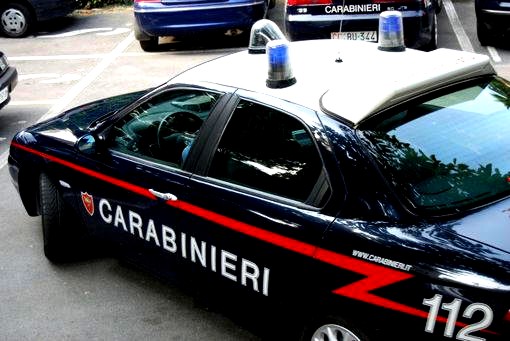
Judge Nencini may have invoked the help of the Carabinieri for reasons going beyond simply very good science.
Italy has among the world’s lowest crime-rates, murder-rates and incarceration-rates. Unusually low criminal and anti-social tendencies among native-born Italians, and strong family pride, explains a large part of this.
But another main reason is the high-profile and exceptionally smart police presence. Deliberately a cool presence rather than a hot and intimidating presence, and in fact a very popular one.
This has allowed for an extremely small court and prison system relative to the size of the population. These principles are now being adopted by of all places New York city.
At its apex is the very well-trained well-funded well-equipped national force, the Carabinieri, about which, in response to a claim that was stupid even by Sollecito’s standards, our main poster Yummi remarked:
The most trusted institutions in Italy above all are the Carabinieri (74% of Italians trust them) and the Polizia di Stato (71%).
Quite possibly the police force with the highest popularity rating in the world. In a recent email about the Carabinieri, Yummi also added the following:
The Carabinieri are a very peculiar police corps. They are indeed a police corps, yet also are formally military; in fact, they have military battalions (elsewhere) and under all points of view they are an extreme elite-corps. As militariy they don’t answer directly to the government but to the President; and from their facilities, you may infer they are a pretty well-trained police force.
They have the popular respect that the US’s FBI would probably like to have. (The two forces do co-operate very closely, and in fact they permanently exchange officers to work on their numerous common cases.)
The only relationship prior to these lab tests of the Carabinieri to Meredith’s case was that Raffaele Sollecito’s sister Vanessa once worked there.
She lost her job for some seriously foolish moves and her appeal to get back in to the Carabinieri was a failure.
So. The Carabinieri. Of possible real significance now in Meredith’s case?
The Carabinieri report directly to the President of the Republic. The President is also the ultimate head of the justice system, deliberately so as set out in the constitution to keep murky politics at bay. He also is wildely popular.
Judge Nencini may be signaling that he wants Italy’s most respected institutions on the side of his verdict. And no more murky politics.
The Considerable Number Of Suspected Perps That Countries Extradite Daily To Other Countries
Posted by Peter Quennell

[Umarked Federal flying paddy-wagon, seen here leaving Seattle, transports 300,000 prisoners annually ]
Extradition is not without its controversies and not all extradition requests see a suspect sitting on a plane handcuffed to a federal marshal.
However, most do, and the US at federal and state level is at any one time processing hundreds of requests and transporting suspected perps hither and thither - the majority, of course, internally between U.S. states, but a large minority are incoming and outgoing.
Complete refusals of extradition seem very rare, as that can cause rebound and ripple effects down the ages.
The US is sort of refusing to send some pilots and CIA operatives back to Italy for trial, but those cases are both in the realm of the quasi military. In the case of the Italian soldiers being held in India for the shooting from a oil tanker of Cochin fishermen they suspected were pirates, even Italy says rules for military must be different.
The US and Italy co-operate on law enforcement more than most countries and the FBI and its Italian equivalent have officers from the other service permanently embedded. We posted on this case of Italy sending an American renegade doctor back to Indiana to face charges.
In general extraditions in both directions between the U.S. and Italy seem to go smoothly and if the State Department ever gets involved (it states that this is Justice Department business) we don’t see any evidence of it in recent reports.
These cases - some of them involving countries sending their own nationals to other countries to face the music - are all live cases on the first 10 of 30 pages when “extradition” is searched on Google News.
- The United States extradites US national David Kramer to Melbourne in Australia. He “has been charged with 10 counts of indecent assault allegedly committed in St Kilda East when he was a teacher at a Jewish orthodox school.”
- Canada rules to send Canadian national Rapinder (Rob) Sidhu a former Royal Canadian Mounted Police officer to the US. “The U.S. indictment… alleges Sidhu… worked with convicted British Columbia smugglers Rob Shannon and Devron Quast to operate a cocaine transportation organization based in British Columbia.”
- The UK sends back Joshua Edwards, a murder suspect, to the US after he fought extradition for five years. He is accused in a 2006 shooting death in Maryland.
- The UK sends back Prine “Prince” Jones to Newark New Jersey. “The 46-year-old Birmingham, England, resident is charged in a superseding indictment with conspiracy to import and export cocaine.”
- Mexico sends back two brothers to New York City “to join a third brother to face sex trafficking charges in New York as part of a complex collaborative effort to combat human trafficking”.
- The UK sends back TV star Robert Hughes to Sydney, Australia. ““He is wanted in connection with allegations of gross indecency, indecent assault and sexual assault towards children in NSW, Australia, between August 1984 and August 1990.”
- Guatamala sends Horst Walther Overdick to New York. “Overdick, known as “The Tiger,” was detained in April during an operation to arrest [very dangerous] Zetas [cartel] operatives in the Central American country.”
- Finland sends Igor Vassiliev to the US. “Igor Vassiliev, 38, a Russian citizen, was arrested in July in Finland, based on an Interpol Red Notice. He is only the third person ever extradited from Finland to the U.S….[in 2005] a federal grand jury handed up indictments charging him with health care fraud and conspiracy to commit health care fraud and mail fraud.”
- The United Arab Emirates sends Kamchybek Kolbaye back to Kyrgyzstan after a two-year legal process. “Kolbayev faces charges of kidnapping, robbery, organization of a criminal group, illegal drug trafficking, and illegal weapons possession,”
- Israel will send Israeli national Aleksandar Cvetkovic to Bosnia. He was arrested in 2011 “on an international warrant after witnesses testified that he had assisted in the shooting of some 8,000 Muslim men and boys in Europe’s worst atrocity since World War II.”
- Ireland extradites Philip Baron to Liverpool in England. “Alleged crime gang boss Philip Baron faces four charges relating to money laundering and conspiracy to import a huge shipment of cocaine and cannabis to the UK from South Africa and Costa Rica between 2005 and 2009.”
- The US may extradite David Headley to India. “CNN-IBN reported US Under Secretary Wendy Sherman as saying, “The US acknowledges Hafiz Saeed is mastermind of 26/11 [Mumbai bomb] attacks. President Barack Obama is determined the US will bring Hafiz Saeed to justice.”
- The UK will extradite British national Lee Aldhouse to Thailand. “Mr Aldhouse successfully fled Thailand after allegedly stabbing American Deshawn Longfellow to death in August 2010. He was later arrested at Heathrow Airport on an unrelated charge when he tried to re-enter the UK.”
- Mauritius has sent Captain Kung back to Taiwan. “Kung was suspected of shooting and killing 12 Chinese sailors [in 1999] on his… fishing vessel during a failed mutiny attempt on Feb. 1999. The vessel at the time was sailing on waters northwest of Mauritius…. Kung was later arrested by Mauritius authorities and sentenced to 20 years in prison.”
- Italy will deport Muiz Trabulsi to Tunisia under an agreements signed by Italy Justice Minister Paola Severino. Muiz Trabulsi is “the nephew of Layla Al-Trablisi, Tunisia’s ex-first lady, to stand trial in Tunisia…. [a part of Tunisia’s eforts] efforts to bring back money stolen by members of the former regime”.
- Bulgaria extradited Stefan Klenovski to Italy, who “had a Europol Arrest Warrant (EAW) issued against him by Italian authorities on suspicions of participating in the crime ring practicing ATM fraud [and], was arrested on January 27 in a shopping mall in downtown Sofia.”
Two more cases are now prominently in the news: Wikileaks founder Julian Assad, holed up in the Ecuador Embassy in London, who the Brits want to extradite to Sweden, and John McAfee, the formoer software magnate now back in the US, who Belize may charge with murdering his neighbor.
Almost invariably while awaiting a final decision those subject to an extradition request have to sit out their appeals in prison. If Amanda Knox is reconvicted in a new appeal trial ordered by the Supreme Court, she could face years sitting in an uncomfortable American prison if her extradition is disputed.
Or, of course, she could willingly move straight to an Italian prison, which as she knows offer in-cell TV, private bathrooms, good career skill-building, and concerts.
[Below: Paola Severino, Italy’s relentless no—nonsense justice minister]
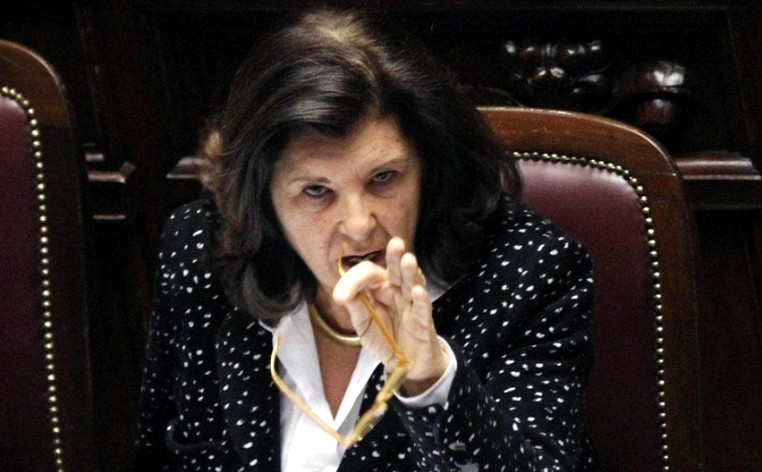
Perugia Police Chief During 2008 Investigation Rises To Head Of National Anti-Mafia Department
Posted by Peter Quennell
[Video commentary and interview in Italian]
Arturo de Felice has served more than 30 years in various police jurisdictions. Now he becomes head of the anti-mafia department in Rome.
He was in charge at the Perugia questura up to August of 2008 when the crime was being jointly investigated with experts from Rome.
Arturo de Felice made the anouncement to the media and a nervous Perugia on the day after interrogators caused Knox’s and Sollecito’s alibis to separate. He announced to the media that Sollecito had admitted lying and Knox had admitted to being at the scene - with Patrick Lumumba, though, not with Guede.
He indicated that police were surprised at how quickly Knox crumbled, and this surprise was confirmed by interrogators themselves and an interpreter at the trial in 2009. From the 7 November Daily Telegraph.
The police said today that Knox’s confession could be the key to solving the case.
Mr De Felice said: “She crumbled. She confessed. There were holes in her alibi. Her mobile phone records were crucial.”
He said Knox’s claims that she was elsewhere had been demonstrated to be false. The police found text messages on her phone from Lumumba, fixing a meeting between them at 8.35pm on the night Miss Kercher died.
The police also said that Sollecito had cracked, and admitted he had lied. Tomorrow morning, all three will appear before a judge to have their arrests confirmed before they are formally charged with non-premeditated murder and participation in an act of sexual violence.
Of course, it was not an especially helpful crumbling by Amanda Knox. Lumumba was released after a lot of time and effort was wasted when a palm print at the scene was identified as that of Rudy Guede.
However in her two written confessions Knox was pretty nasty toward Patrick. Then she let him languish in prison for several weeks. And as Fly By Night posted on the PMF forum last year, Knox had admitted to crimes, if not to murder.
1. She provided the access for a murderer to enter the cottage.
2. She heard thuds and a scream, and imagined what was happening.
3. In her drunken stupor, she failed to come to Meredith’s aid both during and after the murder.
4. She actively covered up the murder by failing to report it or otherwise detail her actions for 4 full 24 hour days following the murder.
In December Knox was interviewed by Mr Mignini in the presence of her attorney and was asked her why she had implicated Patrick. She refused to answer.
At trial she raised no objections to any testimony from those present at the interrogation that she spontaneously fingered Patrick, and she admitted under interrogation that it was her idea.
Mr De Felice comes from Calabria in the deep south (where Dr Galati also comes from) and has headed many mafia investigations in his career. This is dangerous work and those who do it tend to be widely admired in Italy.
CIA v. State Department: A Significant Development For The Perugia Case?
Posted by Peter Quennell

As expected the Supreme Court of Cassation has upheld kidnapping convictions against 23 CIA operatives.
The landmark case dates to Feb. 17, 2003, when Hassan Mustafa Osama Nasr, a radical Egyptian cleric known as Abu Omar [image below}, walked out of his Milan apartment in broad daylight and vanished.
talian authorities used cellphone records made at the time and location of the abduction to determine that CIA officers snatched Abu Omar, drove him to nearby Aviano Air Base and flew him to Egypt. According to Italian court documents,
Abu Omar was beaten and subjected to electric shock in a Cairo prison. He was later freed.
The significant development for Meredith’s case is that the State Department had refused to organize diplomatic immunity with Italy for any of the 23.
Now at least one of them, Sabrina De Sousa (image at top with her lawyer), is suing the State Department for not having stood by her in retroactively organizing that diplomatic immunity.
All 23 could now be the subject of requests for extradition to Italy to serve out their six-year sentences, and if the US Justice Department refuses to comply they could be the subjects of worldwide arrest warrants via Interpol.
That could mean the end of their operational usefulness in the CIA and conceivably prevent any of them ever traveling outside the US again in their lifetimes.
Why have the CIA and the State Department seriously parted company here? Well, their mandates are almost polar opposites.
The State Department and its Embassies and the very considerable American presence throughout the United Nations tries hard to get along with friendly nations, and Italy is probably one of its top half-dozen friends.
The CIA on the other hand is charged with using fair means and foul to fight back against terrorism worldwide, and sometimes its practices contravene the best interests of diplomacy and the local law.
Here the CIA is coming out the clear loser and State is sweetly sitting on its hands and not upsetting Italy in any way.
Cables released so far by the State Department under the Freedom of Information Act suggest that State and the Rome Embassy really didnt ever lift a finger to subvert Italian justice on behalf of Amanda Knox.
Here’s betting more of the same - no action by State - as the Cassation appeal comes alive. And no standing in the way of an extradition request for Knox if Cassation decides Judge Masssei got the trial right.

The Casey Anthony And Sollecito/Knox Outcomes Spark A New Discussion Of The CSI Effect
Posted by Peter Quennell
That seems a good explanation of the so-called CSI effect in the Fox Kansas City video above.
Many crime shows such as the BBC mysteries and the Law & Order series and spinoffs show investigators solving their crimes in the old-fashioned way. Lots of witness interviews and alibi and database checking, and walking around and loose ends and lying awake at night puzzling. And often there’s a big stroke of luck.
But if you watch the very popular CSI Las Vegas series and its spinoffs in Miami and New York, and the various clones on other networks, you will see something very different indeed.
When those shows first began airing worldwide in the late nineties, the producers explained that audiences increasingly appreciate learning something new when watching a show, and it is true, one sure can load up on the trivia.
But you will also see the US equivalent of Dr Stefanoni and her forensic team in those shows, roaming far beyond the narrow crime scene, interrogating witnesses and checking alibis and finding a lot of non-forensic evidence, and even at times drawing guns.
Most unreal is that, time and again, the forensic evidence testing is clearcut and takes just a few minutes and instantly clinches the case.
- There are several articles like this one and this one on whether the Casey Anthony jury was affected by a shortfall in the starkness of the forensics when the behavioral evidence seemed so strong.
- There are several articles like this one and this one on whether the appeal verdict outcome in Perugia might be affected in the same way.
- There are many articles like this one and this one and this one and especially this one saying there is a tough added burden on investigators and juries without a commensurate improved outcome.
With conviction rates declining in the US and Europe, professionals are taking a scientific look at whether the CSI Effect is one big cause of that decline.
At the macro level in the US this writer doubted that the CSI Effect is fatally unbalancing takes on the wider evidence. The same conclusion was reached in this first major study at the micro level.
But the belief in the CSI Effect continues. Articles like this one on an Australian site talk of a backlash against too many acquittals. Some articles like this one argue that maybe lay juries are out of their depths.
The graph at bottom (which we’d like to see updated) showed how the US Feds are still winning juries over and maintaining amazingly high conviction rates. And at state level and lower, judges and lawyers are also taking countermeasures.
In Ohio and many other states prosecutors and judges are acting against a possible CSI Effect in their selection and briefing of juries. And an NPR report came up with these findings.
Some states now allow lawyers to strike potential jurors based on their TV habits. Judges are issuing instructions that warn juries about expecting too much scientific evidence based on what they see on TV.
In the field, Shelton says death investigators sometimes run useless tests, just to show they went the extra CSI mile.
“They will perform scientific tests and present evidence of that to the jury. Even if the results don’t show guilt or innocence either way, just to show the jury that they did it.”
This is coming at a time when death investigators in America have no resources to spare. An investigation by NPR, PBS Frontline and ProPublica shows some states have already opted not to do autopsies on suicides, others don’t autopsy people who die in traffic accidents, and many don’t autopsy people who die over the age of 60.
But Murphy, the Clark County coroner, expects things to get worse.
“You know, we’re in budget cuts right now. Everybody’s in budget cuts. Las Vegas is no different than anybody else. We’re hurting. We’re going to feel that same crunch as everybody else,” he says.
One of Zuiker’s great disappointments is that, for all its popularity, his fictional Las Vegas crime lab didn’t generate more political support to fund death investigation.
“I’ve done my job. You know, we’ve launched three shows that cater to 73.8 million people a week and is a global phenomenon and the largest television franchise in history. We hoped that the show would raise awareness and get more funding into crime labs so people felt safe in their communities. And we’re still hoping that the government will catch up.”
The jury is still out on what really swayed the Perugia appeal jury. Their sentencing report is due out in the New Year. They sure didnt look at very much except for a small fraction of the DNA.
Which leaves us with a big question. How did Judge Hellman brief his jury? Did he warn against the CSI Effect? We’re told this might be his first DNA case, so Cassation will surely look closely at that.
The President Of The Italian Republic Lights A Small Fire Under The Prime Minister
Posted by Peter Quennell
[This post was edited Friday to replace an image with this new video report from Rome]
As they are from separate parties, etcetera, etcetera, they are known to not see eye-to-eye.
We posted here on one role of President Giorgio Napolitano. The ultimate enforcer of the Italian constitution with special reference to the justice system.
On the whole he sides with Cassation and with victims and against political meddling. .
He is also entitled to speak out on Italian politics and the management of the economy. The prime minister seems to be moving on the lines his European partners and global markets would like - but only verrry slowly because of his sea of political and legal troubles.
The president has just drawn attention to this. See this video and report from the BBC.
Italian President Giorgio Napolitano has expressed his frustration at his government’s failure to cope with the country’s worsening debt crisis.
Despite pressure from Italian business and the European Central Bank, Prime Minister Silvio Berlusconi has repeatedly delayed announcing measures to stimulate economic growth.
Speaking ahead of an EU summit, Mr Napolitano said the government had a responsibility to end the delays and take decisive action.
One of a bunch of monkeys has just been lifted off Mr Belusconi’s back. The New York Times reports that a Milan judge has decided not to indict him for tax fraud.
That leaves “only” three pending trials in Milan and his party’s battle with the legal system (which most Italians respect more than any other public institution) is not likely to cool any time soon, even if it is not the most popular or saintly of wars.
Mr Berlusconi takes quite a whack in a polemical new book The Liberty of Servants: Berlusconi’s Italy by the Italian writer Maurizio Viroli . The American monthly Foreign Affairs has an extended excerpt.
Global stockmarkets are already awarding the pending Italian economic measures a small plus. In the stock chart below (set for one year) the red line is the American index (average), the green line is the German index, and the blue line is the Italian index.
Click for a larger image. You can see the Italian uptick in the past several weeks. If you want to follow this chart dynamically in future, save this Yahoo Charts link. You can adjust the time period to suit you.
Italian stocks do remain down 60% from this time three years ago. That could change fast if the current measures work. On global stockmarkets Italy often outperforms Germany and Japan.
The Terrible Weight On The Victim’s Family Because The Italian System Is So Pro Defendant
Posted by Peter Quennell
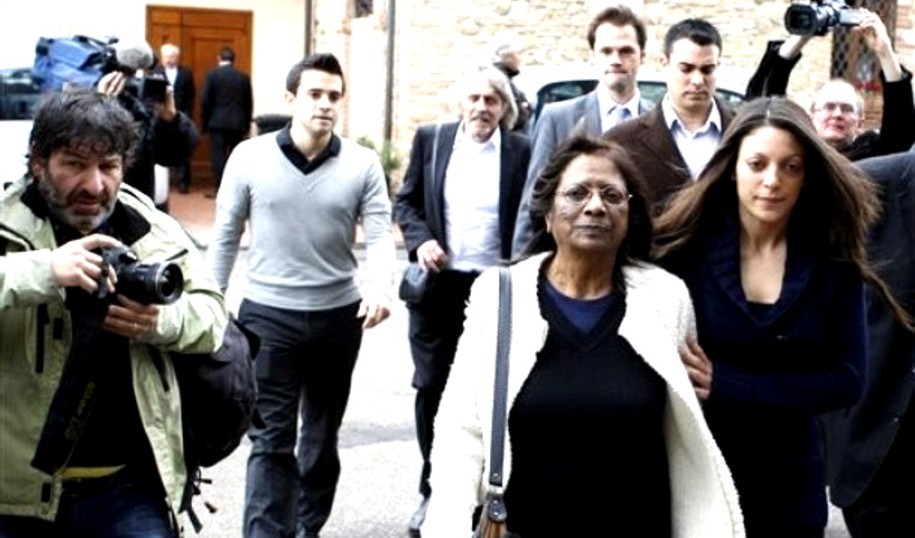
The Italian prison population is proportionally perhaps the smallest in the western world.
Italy has an overall population about one-fifth that of the United States, but a prison population only about one-thirtieth the size of that in the US, below 100,000 as compared to 2.7 million.
It is true that Italy has a very low murder rate, and that most towns see no murders at all year after year. Even now outside the main cities many people still tend to leave their houses unlocked. There seems to be not that many crooks.
But even in light of this, two factors have resulted in sentences often amazingly light by international standards, with prison sentences under three years almost never served, and crooks often happily walk free.
- The first factor is all the safeguards built into the post-WWII constitution to make sure that the kangaroo courts of the fascist era would never ever again reappear.
- The second factor, now in the news, is the manipulation of the justice system by the occasional politician over the years to soften the situations of their locked-up buddies.
So prosecutors now have to jump through a large number of hoops and judge after judge has to check on their reasonableness. Mr Mignini noted this in court the other day when he said that 42 judges had come to see the case against Knox and Sollecito in essentially the same way he presented it. .
Defendants get to speak in court while not under oath whenever they want to. They get two automatic appeals, and verdict and sentence are not considered final until the Supreme Court of Cassation rules that way. The overturn rate on either level of appeal is not particularly high, but there seems a tendency for appeal courts to be more lenient than trial courts, though Cassation often does favor the rulings of the original trial courts.
Now Italian crime rates are creeping up, with the influx of drugs and immigrants, and majority opinion in Italy is that the system should definitely be a bit tougher. Various pro-victim TV shows and various books have shown that because of all the pro-defendant breaks, the toll on victims’ families can be really shocking.
We have posted on the pro-victim campaign of Barbara Benedettelli who is a prominent TV show hoster. She has just come out with a book telling of the sufferings of victims families in saddening detail.
One of the families she describes saw their baby snatched by defense witness Mario Alessi, who soon after killed the baby with a spade because it would not stop crying. Alessi and his wife are locked up now, but you would rarely see in the UK and the US the kind of suffering along the way that the family of baby Tommy went through.
Victims’ families may get some legal and social help but they often end up financially decimated and quite often in poor health. This seems to be the tragic predicament of Meredith’s family which their lawyer Francesco Maresca highlighted the other day.
“You will look Meredith’s family in the eyes only once,” Maresca said. “They could not always be here in court due to the mother’s health problems and siblings’ economic problems.”
In fact, he said, the family had trouble finding airline tickets for the verdict, which the lawyer contrasted with reports that the Knox family had a private jet ready to whisk the American student out of the country in the case of a not guilty finding. Knox’s family has denied the existence of such a plan.
John and Arline Kercher’s bills are said to to be pushing now toward $200,000 at a time in life when their earning powers are no longer at their peak and neither of them are in good health. They have to pay all of their own travel costs to and from Perugia and all of their own hotel bills, and also the fees of Mr Maresca and his team.
Kind attention has just been paid to their terrible plight and to the memory of Meredith by the Italian media, and also in the US and UK by Reuters and the Associated Press and Fox News and The Examiner.
But they deserve a great deal more.
A Token Balance In The Italian System: The Voice In The Court For The Victim
Posted by Our Main Posters
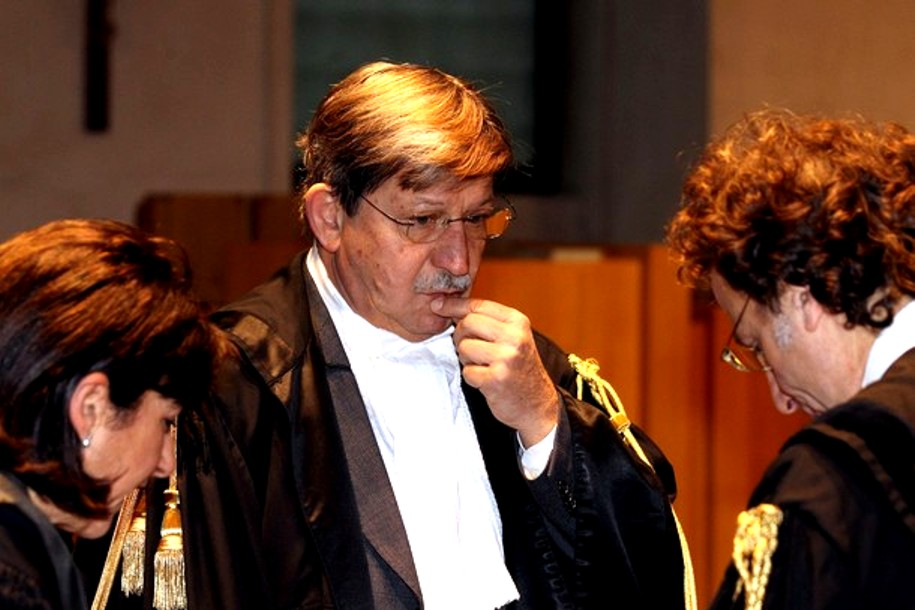
[Above: Francesco Maresca with the Lead Appeal Prosecutor Giancarlo Costagliol and Ms Comodi]
We have often posted before on the pronounced tilt toward defendants’ rights in the Italian court system.
The Italian criminal justice system is just about the only one in Europe that has not yet adapted to the 2001 directive of the European Court that was asking for equality in criminal trials.
As we can see in this case, the system is extremely pro-defendant.
Police and prosecutors have to jump through a large number of hoops. Judge after judge combs through the evidence. Defendants can get up and talk in court at the nod of a judge without being cross-examined.
Defendants never have to take an oath to tell the truth. Judges in effect have to be part of the jury and to stake their reputation on the outcome of every case, the reasoning of which they must describe in writing.
No-one is conclusively declared guilty until two appeals have been concluded. The second appeal is to the Supreme Court of Cassation in Rome, which seems to be sitting on more appeals now than the rest of the western world put together. Just about all prison sentences of under three years are waived.
And that is just for starters. One outcome is a prison population proportionally less than 1/4 that of the United States.
Many Italians feel that this fairness or leniency - call it what you will - has gone way too far, and Prime Minister Berlusconi’s attempts to press the fairness or leniency even further are wildly unpopular.
We posted recently on the tireless Italian campaigner for a stronger assertion of victim’s rights Barbara Benedettelli and she has a new book out on various cases. She has also sent us some background material on the generic issue which we intend to build into a post.
Against this tsunami of systemic pro-defendant bias in Meredith’s case, we really only have the fortitude of the police and the prosecutors involved, and the systemic presence of the lawyer representing the interests of the victim and her family: Mr Francesco Maresca, who practices law in Florence.
Although his English is said to be hesitant - which means the English media don’t usually track him down for any soundbites - he seems to us to be tirelessly aggressive in the court in standing up to the many impromptu interventions of the three perps and the fireworks of their six-plus lawyers.
Here is an interview with Mr Maresca in yesterday’s Umbria Left which was kindly translated by our poster Tiziano.
The lawyer for the Kercher family: Alessi and Avielli contradicted.
“Guede confirms the presence of the accused in the house of the crime. We have heard witnesses who contradicted Mario Alessi and Luciano Aviello.” Thus said lawyer Francesco Maresca, lawyer for the family of Meredith Kercher, at the end of the hearing of the appeal trial of Raffaele Sollecitoand Amanda Knox.
“Witnesses which,” he added “we could have however done without, heard only because it was necessary from a procedural point of view.” Lawyer Maresca claimed, “Regarding Rudy Guede, this person confirmed what he wrote in the letter to his defence lawyers. And to the specific question whether it was an opinion of his, he replied ‘no, it’s what I experienced that night’.
“In my opinion Guede once again confirmed the presence of all three accused at the site of the murder that night. It seems to me the truth of a co-accused already found guilty. To me it appeared absolutely clear,” Maresca concluded.
Another one landed for Meredith by her lone ranger in the court.
Italian Judge Ruling Is Tough But Fair In Another Case Involving Americans
Posted by Peter Quennell
We’ve seen no trace of anti-Americanism in the Perugia case, other than restrained reactions by prominent commentators to some strident anti-Italianism from the US.
Typically the two populations get along and like one another, they eagerly buy one another’s products, they visit one another’s countries in droves, and at the political level Italy and the US are very close allies.
So. Does the Italian judiciary perhaps have a covert beef against Americans?
We don’t see that one either. The main Americans that Italian judges see appearing in front of them are students, who seem to have quite a knack there for dropping themselves in it. We don’t post on all those cut-short escapades, but there are several a year reported, and we did post on two that happened in Florence.
All of the student cases are treated humanely, and the American Embassy in Rome is not kept particularly busy lecturing Italians on how to handle each case. Actually because of this case the Embassy keeps a very low profile.
Judge Oscar Magi (image above) has now issued a 200-page explanation of his mainly-guilty ruling in the CIA kidnapping case. (This document is the equivalent of what we will see within a month on Meredith’s case.)
Fearless, tough, and seemingly fair. The New York Times impartially reports.
The Italian secret service was most likely aware of, “and perhaps complicit in,” the abduction of an Egyptian cleric from the streets of Milan in 2003, a judge in Milan said Monday. But, he added, state secrecy prevented the court from proving this.
The statement by the judge, Oscar Magi, was part of a 200-page document explaining his reasoning behind the landmark November ruling that convicted 23 Americans, most of them Central Intelligence Agency operatives, of kidnapping the cleric. It was the first case to yield convictions in the practice of “extraordinary rendition,” in which terrorism suspects are captured in one country and taken to another, where they may be subjected to coercive interrogation techniques.
Judge Magi convicted a former C.I.A. base chief and 22 other Americans of kidnapping in the abduction of an Egyptian cleric, Osama Moustafa Hassan Nasr, also known as Abu Omar, on Feb. 17, 2003. Prosecutors said the cleric was taken from Milan in broad daylight and flown from an American air base in Italy to a base in Germany and then on to Egypt, where Mr. Nasr asserts he was tortured….
Judge Magi acquitted three Americans, citing diplomatic immunity, and two Italians, citing state secrecy. Tried in absentia, the other 23 Americans are considered fugitives and are sought under a European Union arrest warrant. Through their lawyers, they pleaded not guilty….
The Italian government is not expected to request extradition of the Americans, who are not expected to serve jail time. Still, the case marked the first time a judge in an allied country had placed C.I.A. agents on trial.
Judge Magi wrote that in 30 years as a penal judge, he had “very rarely” heard testimony “so precise, attentive and correct regarding such difficult and serious investigations,” adding that he had never seen a penal trial in which events had been reconstructed with such “certainty” and “such a degree of authority.”
Why The Italian Judiciary Is Probably Less Prone to Pressure Than Any Other In The World
Posted by Commissario Montalbano

Image above: The Consiglio Superiore della Magistratura in session
Some of the very best lawyers in the UK and USA and around the world are learning a lot about the Italian system by way of the Perugia trial - and are in many, many ways impressed.
Italian magistrates enjoy an extraordinary level of autonomy from the other powers of government (executive and legislative) and the point of this post is to explain why. This autonomy is above all due to the Italian constitutional framework.
That framework is intended to guarantee such an exceptional level of independence so as to avoid the abuses that occurred during Mussolini’s fascist regime, when Italian magistrates were forced by the executive to prosecute (and persecute) political opponents to the fascist dictator.
The source of such independence is set forth in Title IV of the Italian Constitution which in particular provides for an independent body [image at top here] which is called the “Consiglio Superiore della Magistratura” or C.S.M. (Superior Council of Magistrates). This is the self-governing body for Italy’s judiciary, and it comprises ordinary (civil and criminal) judges and prosecutors.
Its competence is based upon Articles 104 and 105 of the Italian Constitution, as well as several ordinary laws. Article 105 says that the C.S.M. is responsible for the hiring, training, assignments, transfers, promotions, appointments to the Supreme Court of Cassation, disciplinary actions and terminations of all Italian judges and prosecutors.
Article 104 opens with the statement: “Magistrates constitute an order autonomous and independent from any other power”. The article then proceeds to provide norms relating to the composition of such a self-governing body.
In order to guarantee the independence of magistrates and in accordance with the general principle of the balance of powers, the constitution establishes a mixed composition of the members of the CSM.
According to the constitution, two thirds of its components are in fact judges elected by all magistrates (judges and prosecutors) in special nationwide elections of the CSM (these are called “membri togati”, i.e. judicial members).
And one third is chosen by Parliament among law professors and attorneys with at least 15 years of experience (these are called “membri laici”, i.e. lay members). And in addition, there are three so called “˜De Jure’ members:
- the President of the Republic, who is the President of the CSM
- the President of the Supreme Court of Cassation
- the General Prosecutor before the Supreme Court of Cassation
The CSM then elects the Vice President of the Council choosing among its lay members appointed by Parliament. The Vice President is the real acting President of the CSM, since the role of the President of the Republic is primarily symbolic. The current Vice President of the CSM is Nicola Mancino [image below} who is a former Speaker of the Italian Senate.
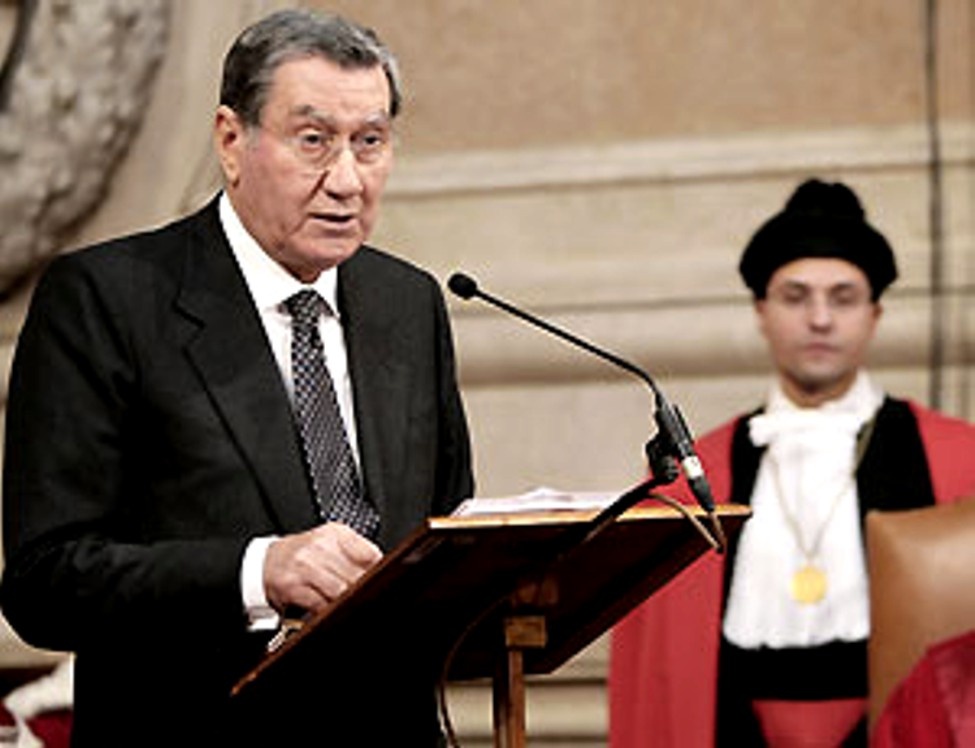
Image above: Nicola Mancino, Vice President of the C.S.M., addressing the Council
The constitution establishes the above mentioned proportions, but not the number of members. However a law passed in 2002 sets the number of elected members at 24. Therefore at present there are 16 members (all judges) elected by magistrates and 8 members appointed by Parliament. With the three “De Jure” members the total is therefore 27 members.
The position of member of the CSM is incompatible with that of legislators, therefore CSM members cannot be members of Parliament or members of the Regional Assemblies.
Art. 107 reiterates the extraordinary independence of magistrates (judges and prosecutors) by stating: “Magistrates are not removable. They may not be dismissed or suspended or transferred to other locations or functions if not after a decision of the CSM, adopted either for reasons and with the guarantees established by law or with the magistrate’s consent.”
Ordinary laws also confer other powers to the C.S.M. including the power of giving opinions to the Government and to Parliament on proposed laws affecting the order of magistrates and the judiciary in general.
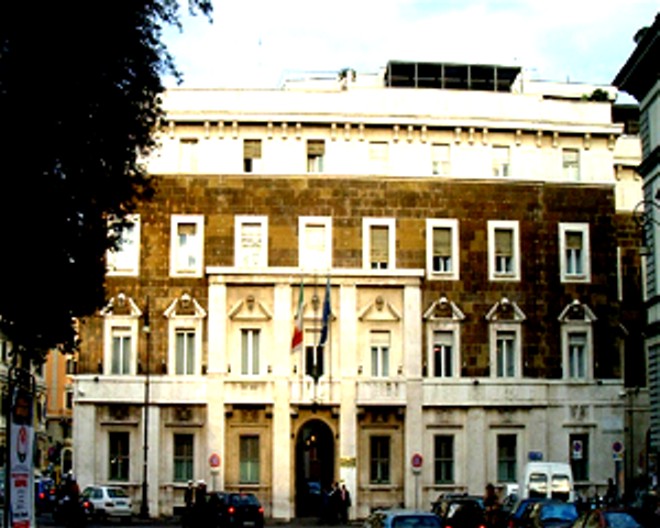
Image above: Palazzo dei Marescialli in Rome. The Seat of the C.S.M.
The extraordinary independence of Italian magistrates, especially considering that Italy is probably the only country in the world where not even State prosecutors report to the executive power, has created a lot of tensions between magistrates and politicians.
The Italian Prime Minister, Mr Silvio Berlusconi, who is indicted and undergoing prosecution in over twenty separate cases, some of which already concluded (for bribing of judges, illegal campaign financing, tax evasion, fraudulent accounting) dating back to the time before he entered politics in 1994, has often accused magistrates of having proceeded against him for politically motivated reasons.
His pressures on the CSM to discipline those magistrates whom he alleges are politically motivated in their prosecutions against him, have not succeeded, and the CSM has always defended the actions of magistrates against the frequent attacks from the executive power and from the many politicians who are under investigation for corruption and other crimes.
Recently Mr Berlusconi’s coalition passed a law to guarantee immunity from prosecution to the four highest offices of the Republic, including that of the Prime Minister, but the Supreme Constitutional Court struck it down as unconstitutional.
Currently out of 945 Members of Parliament in the two houses, there are about two dozen convicted felons and over 70 more under investigation by Italian magistrates. They’re all holding to their seats very tightly, since all members of the Italian parliament are immune from arrest, if not from prosecution.
Pressure on this extremely powerful and immune judiciary has not worked where real heavy-handed political and media persuasion was attempted. Be assured, the judiciary in Perugia will take no notice of it at all.
Why The Prosecutors In Italy Are Relatively Popular
Posted by Peter Quennell
Italy’s a tough country with, albeit dwindling now, a legacy of violent crime, and many brave prosecutors over the years have been assassinated.
And the Italian legal system is not particularly weighted in their direction, with a large number of hurdles they have to climb over before a case ever gets to trial.
And the Italian prison system is relatively lenient, heavily pro-prisoner-remediation and early release, and proportionally only 1/10 the size of the US’s.
So the endemic attempts to undermine Prosecutor Mignini have invariably won only MORE popular support for him and his case in Perugia and Italy in general.
And the only “criminal charge” against him (it isn’t) seems to flow from his guessing right in the Monster of Florence case - and apparently no charge of this kind has ever won a “conviction”.
Above is Milan Prosecutor Armando Spataro.
He is in the news now because he has demanded prison sentences for TWENTY-SIX Americans.
Between them they seem to have colluded in grabbing Osama Moustafa Hassan Nasr, an Egyptian in Italy, back in President Bush’s day, and taking him off to be tortured.
Not to the United States where torture is not legal, but to Egypt where it more-or-less is.
Human rights advocates charge that renditions were the CIA’s way to outsource the torture of prisoners to countries where it was practiced.
The CIA has declined to comment on the Italian case, and all the Americans are being tried in absentia and are considered fugitives.
As we remarked in this post it is pretty hard for a foreign government and especially now the American government to throw sand in the Italian wheels of justice.
The American government is really just sitting this one out. And it may be covertly delighted when Amanda Knox and her clan fade to silence.
Impressive Public Push In Italy, Anti Crime, Pro Stronger Justice System
Posted by Peter Quennell
Four months ago now, Nicki presented us with this very enlightening picture of Italian justice.
Two of the important conclusions of Nicki’s piece relevant to the case in Perugia:
- The Italian system of justice is not only fair and cautious, it is painstakingly so, almost to the n’th degree.
- Prosecutors do not have an easy time of it, and they have to clear hurdle after hurdle to make their case.
The system may not be ripe for any great changes, but the Italian public certainly seems to be favoring law and order.
Now there’s been a huge anti-Mafia turnout in Naples. Click above for the BBC’s report.
“They Were Held For A Year Without Even Being Charged!!” How Italian Justice REALLY Works
Posted by Nicki

[Above: Cassazione, the Italian Supreme Court Of Appeals}
A misleading mantra
This frequently quoted claim above is maybe the most mindless and misinformed of all the mantras on the case.
Much of the US media and some of the UK media - sometimes enthusiastically, sometimes with reserve - has parroted the claim that Raffaele Sollecito and Amanda Knox were “held without charges” for nearly a year.
Perhaps bringing to mind the notion of two innocent bystanders to the crime being arbitrarily arrested? Locked up in cockroach-infested jails by abusive police? Led on by an evil prosecutor with endless powers up his sleeve, and nothing at all to slow him down? Lost and forgotten by any judges in the case?
Well, good luck with that one, if it’s designed to sway the process.
It irritates just about everybody here in Italy, the judiciary and the media included. And it is doing the defendants no good at all.
Negative stereotypes like these really should not be applied to a country that is one of the founding members of the EU, of NATO, and of the European Council, and of the G-7, G-8, OECD, and United Nations (the non-permanent member of the Security Council in 2007-2008).
So for media reporters and commentators, please let us get the facts straight. Once and for all?!
Origin of Italian jurisprudence
Italian jurisprudence developed from Roman Law. It was shaped in the course of history to become a modern and very fair system. Judicial powers are subjected to a very complex and extremely pervasive set of checks and balances, which really assure maximum protection of every citizen’s rights.
Comparing the US and UK common law system - a model founded on non-written laws and developed through judicial proceedings - with this system which arose from the Roman Law model - based on a written civil code - is really like comparing apples to oranges.
They were both conceived to protect individual’s rights at a maximum level, while seeking justice for the victims. But with entirely different processes.
One is not necessarily better or worse. But there are legal experts who think the Italian system is distinctly fairer - much more weighted toward the defendants. In the US and the UK the prosecutor usually has to make it through only one pre-trial hoop. In Italy the prosecutor has to make it through a whole row of pre-trial hoops.
Legal status of a witness and a suspect
Let’s see what happens in Italy to the legal status of a person who, while considered a “persona informata dei fatti” which means “a person who could yield useful information” in relation to a brutal murder, suddenly becomes a suspect in the eyes of the police.
If while interviewing the “person who could yield useful information” the suspicion arises that such person could have played an active role in the crime, their status then turns into that of a suspect. The police can then detain that suspect up to 48 hours.
Those 48 hours are the period within which a prosecutor - if he believes that the evidence of guilt is meaningful - can request a validation of the arrest by the Judge of Preliminary Investigation (the GIP).
If the judge agrees with the prosecutor that a serious indication of guilt exists, a warrant for the arrest is issued by the judge, and the person’s detention is thus validated.
Immediately, as soon as the status of “person who could yield useful information” status changes into the status of a suspect, the suspect person has a right to legal counsel. This legal counsel normally immediately appeals for the release of the suspect.
Subsequent hearings by different judges
Thus setting in motion what can be a LONG sequel of hearings - for which in US and UK common law there is no such equivalent. Each hearing is headed by a different judge. This judge examines prosecution and defence arguments, and decides if the suspect may be released on any of these bases:
- Seriousness of the clues presented by prosecution
- Likelihood of repeating a similar crime
- Likelihood of fleeing the country during the ongoing investigation
- Danger of tampering with, or fabricating evidence
If every one of the defence appeals fails, in front of a number of different judges, in a number of different hearings, and the investigation is officially closed, the suspect then goes on to a pre-trial hearing.
Once again here, yet another judge rules either to clear and release the suspect by rejecting the submitted evidence, or to send the suspect to trial on the basis of that evidence, thus making the charges official.
Judicial decisions on bail, house arrest, or jail
Now that the charges are official, the judge can decide if the defendant must await trial under house arrest, or in freedom, of if the defendant must remain in jail.
If the judge, based on their knowledge of the crime and the defendants, estimates that the chances of re-offending or fleeing the country are high, the suspect must remain in jail.
So nobody in Italy can be detained without a reasonable suspicion, a long series of judicial hearings (any one of which could set them free) or eventual official charges.
Amanda Knox and Raffaele Sollecito have not in fact been incarcerated for over one year due to zealous police or a bizarre prosecutor or the complicity of a number of judges throughout the process.
They have been incarcerated because an articulate and balanced process of law has officially and very fairly established there are strong indications that they willingly participated in the vicious murder of Meredith Kercher.
Failure of defenses to persuade judges
Their own lawyers have put up a tough fight for Raffaele Sollecito and Amanda Knox throughout the judicial process. But they have simply failed to convince the judges throughout that process.
One that actually seems strongly weighted in their favor.
